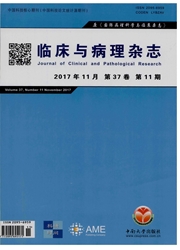

 中文摘要:
中文摘要:
靶向治疗是腹部肿瘤个体化精准医疗的重要组成部分,在胃肠间质瘤的疗效尤为显著,被誉为"现代抗肿瘤治疗的典范"。影像学是目前临床评价腹部肿瘤靶向治疗疗效的常用手段。由于肿瘤靶向治疗后组织学变化多样,实体肿瘤疗效评价标准(response evaluation criteria in solid tumors,RECIST)存在形态学偏倚;Choi及mChoi、SACT(size and attenuation CT)、MASS(morphology,attenuation,size and structure)等标准联合CT值指标,解决了肿瘤坏死囊变导致体积增大的问题。正电子发射断层显像(positron emission tomography,PET)、磁共振扩散加权成像(diffusion-weighted imaging,DWI)、磁共振动态增强扫描(dynamic contrast enhanced magnetic resonance imaging,DCE-MRI)及单能CT等新技术的探索应用,一系列功能影像学参数[标准摄取值(standard uptake value,SUV)、表观扩散系数(apparent diffusion coefficient,ADC)、K-(trans)、碘浓度值等]为肿瘤靶向治疗疗效的预测和治疗后早期评估提供了新的潜力指标。图像纹理分析技术则可深入挖掘影像学信息,提供丰富量化参数供临床评效参考。影像医生应通过多学科诊疗协作组(multi-disciplinary team,MDT)等模式加强与临床沟通及开展联合科研,积极探索新的参数和标准,进一步提高腹部肿瘤靶向治疗疗效预测和评价水平。
 英文摘要:
英文摘要:
Targeted therapy is an important component of the individualized precision medical treatment for abdominal tumors. It is especially effective in the treatment of gastrointestinal stromal tumors, which is regar-ded as “a model of modern anti-cancer therapy”. Radiology is the common method to evaluate the response of ab-dominal tumors to targeted therapy. The morphological bias is demonstrated in response evaluation criteria in solid tumors (RECIST) because of the diverse change of post-treatment tumor tissue. The problem of enlarged tumor caused by necrosis and cystic degeneration was resolved by combination of Choi,mChoi, size and morphology (SACT), morphology, attenuation, size and structure (MASS),and CT values. The new technologies of positron emission tomography (PET), diffusion-weighted imaging (DWI), dynamic contrast enhanced magnetic resonance imaging (DCE-MRI) and monochromatic CT, and a series of functional imaging parameters including standard uptake value ( SUV) , apparent diffusion coefficient (ADC) , KtIdns value and iodine concentration, pro-vide potential surrogate for the prediction and early evaluation of tumors to targeted therapy. Texture analysis tech-nique in radiology can further explore the radiological information, to provide rich quantitative parameters for re-sponse evaluation. The radiologists should strengthen the communication with clinicians and initiate cooperative research through multi-disciplinary team (MDT) patterns, actively explore new parameters and criteria to further improve the response prediction and evaluation of targeted therapy for abdominal tumors.
 同期刊论文项目
同期刊论文项目
 同项目期刊论文
同项目期刊论文
 Fused monochromatic imaging acquired by single source dual energy CT in hepatocellular carcinoma dur
Fused monochromatic imaging acquired by single source dual energy CT in hepatocellular carcinoma dur Applicable apparent diffusion coefficient of an orthotopic mouse model of gastric cancer by improved
Applicable apparent diffusion coefficient of an orthotopic mouse model of gastric cancer by improved Diffusion-weighted magnetic resonance imaging in the depiction of gastric cancer: initial experience
Diffusion-weighted magnetic resonance imaging in the depiction of gastric cancer: initial experience 期刊信息
期刊信息
